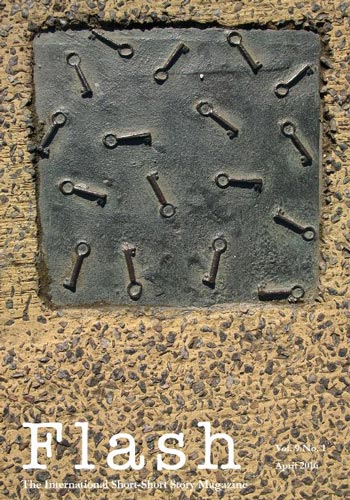Flash: The International Short-Short Story Magazine – April 2016
Like all good storytellers, the authors published in Flash: The International Short-Short Story Magazine invite the reader to come close and listen carefully. Only, these authors do so in 360 words or less. David Swann best captures the feeling of storytelling in his piece, “The Story of Her Eye” when he writes, “strangers are the best audience. But stories hate distance.” Flash bridges this distance. The journal is at its best through humor and sometimes fantastical pieces that pull you close.
Like all good storytellers, the authors published in Flash: The International Short-Short Story Magazine invite the reader to come close and listen carefully. Only, these authors do so in 360 words or less. David Swann best captures the feeling of storytelling in his piece, “The Story of Her Eye” when he writes, “strangers are the best audience. But stories hate distance.” Flash bridges this distance. The journal is at its best through humor and sometimes fantastical pieces that pull you close.
There’s no better way to bridge distance than laughter and Flash opens with parody through Chuck Calabreze’s piece, “Best American Poetry, Donald Trump, Guest Editor.” Calabreze dives fully and immediately into character, “This is going to be a tremendous collection of American poems. There’ll be no Mexicans in the volume [ . . . ] The U.S. has been a dumping ground for everybody else’s bad poets for too long.” The humor strikes its point and knows when and how to linger even in such a short piece. And as a true invitation, Calabreze addresses the reader through a sparing but well-conceived use of second person: “there’ll be no whining about who gets in and who doesn’t. All you losers can just get over yourselves.” Calabreze breaks the wall between narrator and reader, inviting us to laugh from start to finish.
“The Brazilians” by Ana Maria Shua (translated by Steven J. Stewart) keeps us laughing. This laughter emerges from an embarrassing story where the narrator describes a dream they had as a child about two Brazilians: “They were green and were vomiting flowers. They had very long necks.” As it turns out, the narrator was thinking about brontosaurusi. But beneath the humor, Shua touches on themes of remembrance, reality and dreams. “My memory of what really happened is different from my memory of the dream.” Shua couches the intimacy of this reflection in folds of humorous storytelling we are already invested in. She has captured our attention with a laugh and we will follow her anywhere.
Vanessa Gebbie strides into the fantastical in her story “Triangularity” where Sammy Etherington wakes up to discover his head is a triangle. Gebbie utilizes this bizarre situation to draw us into his fear that his wife won’t love him with his odd shaped head. Part story about gaining self-awareness and part romance, the piece is hopeful and charming. Sammy’s wife explains to him that his head always changes shape; he just hasn’t noticed. ‘“I love you whatever shape you are [ . . . ] when you’re sad, you’re rectangular [ . . . ] Happy, your face is completely round, like the moon.” A surprisingly tender piece, Gebbie knows how to work short speculative fiction for big emotional impact.
Jon Davis, places us into a young boy’s mind in “Confirmation Name.” Through third person prose, Davis draws us close enough to the narrator John to laugh at his awkward fumbling and empathize with his quest to choose his confirmation name and, therefore, his identity. “John was out. That was his name. Ringo was not allowed. So it was George or Paul.” Davis’s characterization through The Beatles creates a compelling protagonist we can’t help but smile at when he blurts out his choice of name to Shelley, the cute cheerleader. But the story brings us too close to John. John plays into harmful gender stereotypes that depict him rescuing the girl as the pinnacle of his identity and manhood. Davis ends with John’s fantasy of killing the wolf and how he would “[slice] open its stomach to free the sobbing girl.” We’re too close to John now; no longer strangers at all, but close enough to fault him and that ruins the magic of the story.
With flash fiction, there is no time to become a character’s best friend. But in Flash, we become characters’ confidantes. Through humor and the bizarre, Flash publishes intimate stories which close the distance between narrator and reader. We are not with the characters for long, but we are close and we are listening.
[www.chester.ac.uk/flash.magazine]





